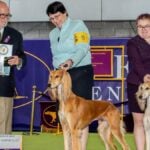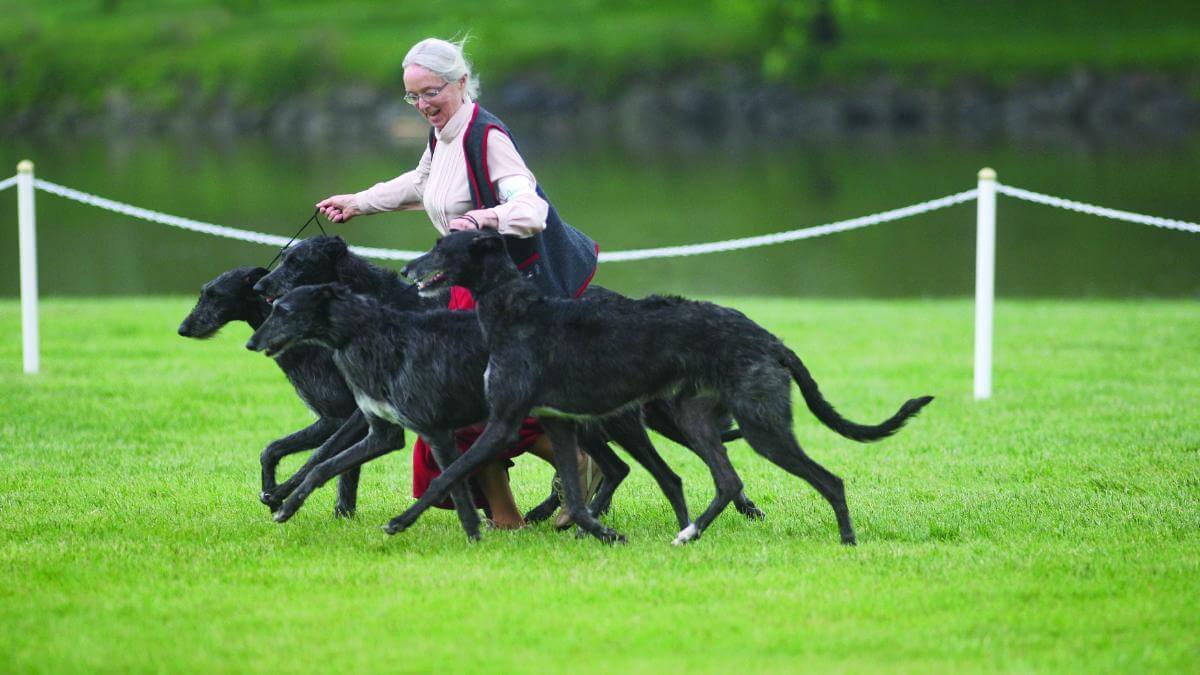
Home » Barbara Heidenreich | Fernhill

Barbara Heidenreich
1. A solo bicycling venture as a young teen around Scotland in 1963 exposed me to my first Scottish Deerhound, “Argyll,” on a couch at the Kilmartin Hotel (check out SHOWSIGHT interview February 13, 2023). Finding any information about Deerhounds at that time in Canada was virtually impossible, but I tracked down Audrey Benbow (Sirhan), Gayle Bontecou (Gayleward), and Jan Buchanan (Auldstane), and then in 1970, headed off with my first Deerhound to Columbia University in Manhattan (was I crazy?)!
My first litter arrived on March 6, 1975, and Fernhill Scottish Deerhounds, named after my favorite Dylan Thomas poem, was established. Officially, being a breeder has not been easy, as my professional careers have been very demanding, sending me to Brazil (without Deerhounds), to Labrador (with Deerhounds), and to British Columbia (with Deerhounds), but I have bred/co-bred 43 litters over the past 50 years. In retrospect, I’m grateful to the Deerhounds—they’re the reason I bought a 200-acre farm an hour east of Toronto back in 1973. It gave me the space to raise and course my Deerhounds, and to build a herd of Highland Cattle that eventually reached 90 head.
2. The incredible temperament of Deerhounds; loving, perceptive, with not-too-bright needy males and smart, independent females… catatonic in the house, and the daily “bat-sh*t crazy zoomies” outdoors have all kept me entranced. Their elegant greyhound-type beauty is a hallmark of the breed. Maintaining this athletic look is essential, as a Deerhound is not a “smaller Irish Wolfhound” but, as the Breed Standard lists as No. 1, “Typical … a rough-coated greyhound of larger size and bone.” Their sheer joy in coursing real or “mythical” deer is ingrained; I marvel seeing this historical, functional link appear daily as I watch them on my farm pursuing their passion.
3. Yes, I have a long waiting list and each inquiry receives a copy of my Primer (an updated description of what it is like, and what is required, to live with a Deerhound) and a copy of my contract (seven-year health guarantee for the breed’s hereditary issues) before I send them to another breeder who actually has puppies. Some do turn their interest into a commitment, but it is a breed with specific needs that not everyone can supply.
4. Additional Deerhound-specific genetic health tests are a recent positive addition, plus current research on the relationship between diet and cardiomyopathy in the large breeds (after the hiatus on the FDA’s withdrawn accusation linking dilated cardiomyopathy (DCM) to the boutique, exotic, grain-free “BEG” brands), all of which have been added to my Primer.
My pleasure in mentoring, which was missing in my initial years in the breed until I went to the UK Breed show in 1977, has led me to assist in establishing a “Scottish Deerhound Learning Centre” on Facebook, where questions can be posed, and collective answers provided, so new owners benefit from the experience of longtime owners. I enjoy Facebook as a mechanism for keeping up with my puppies and for the increasing online archives of historical magazines and books describing the working Deerhound of the 1800s, which are a goldmine for understanding function in this breed!
5. I follow the research on the comparison of health issues between purebred dogs and mixes, so I am prepared to address the argument that mixes are healthier. However, I don’t think the purebred community uses its strongest case for purebred dogs sufficiently; that is, the predictability of each breed’s temperament, behavior, and husbandry needs so that prospective owners can choose the right dog based on their situation and lifestyle.
6. I have some concerns about retired handlers now dominating as judges, a far cry from when I started showing in the 1970s and ‘80s when Breeder-Judges were the norm. I see a tendency to ignore the American Kennel Club’s (AKC) requirement for selecting a type and structure that reflects the breed’s function, as very few judges have watched Deerhounds coursing. Instead, there appears to be a focus on presentation and the “all-American show dog,” rewarding size in our breed (non-functional, plus shorter lifespans), over-angulation, and more coat with a resulting loss of our breed’s “greyhound type.” Not requiring judges’ critiques in North America doesn’t help the situation. The drop in numbers in terms of coursing and showing is a concern, as are digitally enhanced advertisements and the rush to use sires that have been heavily campaigned, but not seen in person, instead of selecting for the qualities the bitch needs.
7. (1) Research into breed-specific health/genetic issues, thanks to Dr. Guillermo Couto DVM, and others, through the Greyhound Health Initiative, has done so much to explain biological differences between Greyhounds/Sighthounds and other breeds, which has resulted in better medical knowledge and a greater focus on health issues and genetic testing within our breed. (2) The increased ability to import/export dogs and frozen semen globally, thus allowing greater diversification of the gene pool. (3) The posting of videos and photos of so many shows and coursing events on Facebook’s personal and group sites provides virtual participation and the opportunity to regularly see your friends, especially those veteran two-legged “besties” who have been, for the past century (and still are!), running around the ring. YEA!